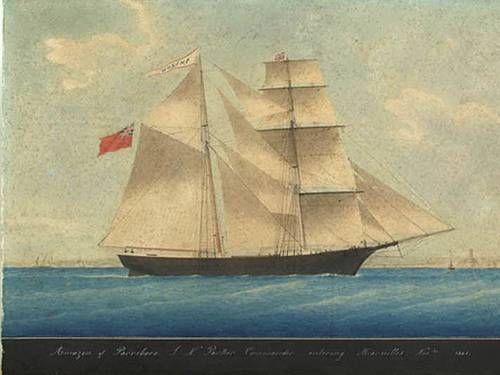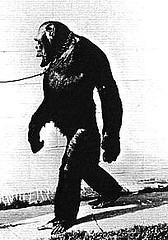
Carhenge is a replica of Stonehenge constructed of vintage American automobiles spray-painted gray. The heel stone is a 1962 Cadillac.
Who says Americans have no taste?

Carhenge is a replica of Stonehenge constructed of vintage American automobiles spray-painted gray. The heel stone is a 1962 Cadillac.
Who says Americans have no taste?

Passengers and crew of the Mary Celeste, a 103-foot brigantine that left New York for Genoa on Nov. 7, 1872:
A month after she sailed, the ship was found abandoned off the coast of Portugal. Her cargo was intact, and she carried a six-month supply of food and water. The sextant, chronometer and lifeboat were missing, suggesting that the ship had been deliberately abandoned.
No survivors were ever found. The mystery has never been solved.
Twins Grace and Virginia Kennedy were severely neglected by their San Diego parents, attended minimally by a German-speaking grandmother. They saw no other children, rarely played outdoors, and did not go to school.
They were 8 years old when a speech therapist realized they had invented their own language:
GRACE: Cabengo, padem manibadu peeta.
VIRGINIA: Doan nee bada tengkmatt, Poto.
It was apparently a mix of English and German, with some original words and grammatical oddities.
Their father soon forbade their speaking it, saying, “You live in a society, you got to speak the language.” They learned English, but they still bear the emotional scars of their neglect: Virginia works on an assembly line, and Grace mops floors at a fast-food restaurant.
Somewhere, J.F. Byrne is laughing at all of us.
A friend of James Joyce (he was the basis for Cranley in A Portrait of the Artist as a Young Man), Byrne announced in 1918 that he had devised a simple and unbreakable code system, called the “Chaocipher,” that would fit into a cigar box:
I had, and still have in mind, the universal use of my machine and method by husband, wife, or lover. My machine would be on hire, as typewriter machines now are, in hotels, steamships, and, maybe even on trains and airlines, available for anyone anywhere and at any time. And I believe, too, the time will come — and come soon — when my system will be used in the publication of pamphlets and books written in cipher which will be unreadable except by those who are specially initiated.
Unfortunately, no one was interested. The U.S. Signal Corps, the State Department, the Department of the Navy, AT&T — all turned him down.
Finally, Byrne published a lengthy coded message in his autobiography, offering $5,000 to anyone who could decipher it. A few years later, he quietly died, taking the secret with him.
The cipher has never been solved.
01/29/2014 UPDATE: In 2010 Byrne’s family donated his papers to the National Cryptological Museum, so the algorithm is now known. (Thanks, Peter.)

Created by Native Americans at least 1,000 years ago, Ohio’s Serpent Mound is a double mystery.
First, while there are several burial mounds nearby, the serpent itself doesn’t contain any human remains. It’s just a giant earthen snake, 1,330 feet long.
Second, the site on which it’s built shows faulted and folded bedrock, meaning that a huge cataclysm, a meteorite or a volcanic explosion, happened here in the ancient past.
Is that why the serpent was built there? We may never know.
When French psychologist Michel Gauquelin set out to determine whether astrology was valid, he found a curious anomaly.
His analysis showed that sports champions are more likely to be born when Mars is in the fourth quadrant. Examples include Babe Ruth, Muhammad Ali, Tiger Woods and Venus Williams.
It’s called “the Mars effect.”
French forger Vrain Denis-Lucas must have had a golden touch. His customers bought “manuscripts” from all of the following authors:
… even though all of them were written in contemporary French. All told, Denis-Lucas sold 27,000 manuscripts before the French Academy of Science realized something was wrong. He spent two years in prison and then disappeared.

“Man is the noblest work of God!” roared Mark Twain. “Well now, who found that out?”
Consider the case of Oliver the chimpanzee. Oliver liked to stand upright instead of knucklewalking like his peers, and his keepers noticed that his face was flatter than other chimps’, who tended to avoid him.
That’s all the impetus they needed. Throughout the ’70s and ’80s Oliver was paraded through a succession of theme parks, zoos and promotions, billed as a missing link or even a “humanzee,” or human-chimp hybrid, and confined for seven years in a cage that measured only 7 by 5 feet.
It all came to nothing. In 1996, when Oliver was old, blind, and arthritic, University of Chicago geneticist David Ledbetter checked his chromosomes and discovered he was just an ordinary ape, albeit one who preferred to walk upright.
It’s still possible that Oliver belongs to a rare subspecies of chimps who resemble humans … but after that treatment, would he take that as a compliment?
Lloyd’s of London does not charge higher insurance rates for ships passing through the Bermuda Triangle. It says the area is no more dangerous than any other high-traffic piece of ocean.
The U.S. Coast Guard agrees.

This conical tower, part of the Great Zimbabwe ruins of sub-Saharan Africa, has stood for a thousand years, and we may never learn what lies inside: The tower is 30 feet tall and has no windows or doors.